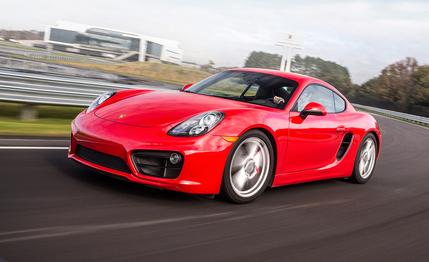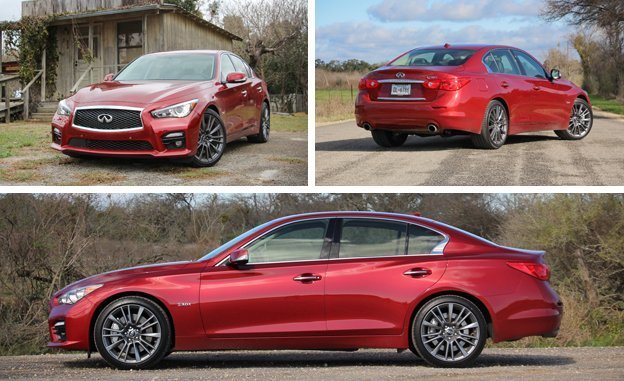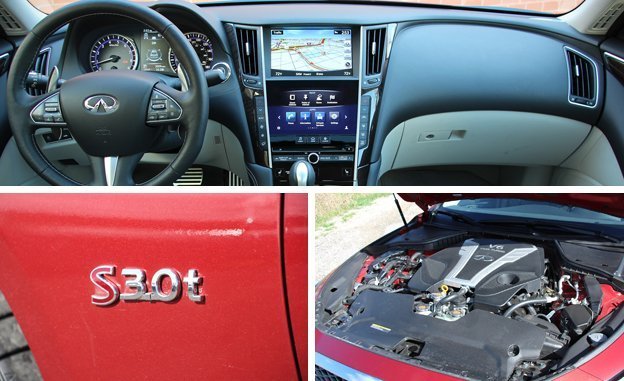
 First Drive Review
First Drive Review
At Car and Driver, our love of sports sedans is well-known, and Infiniti built one of the best such cars in recent memory. It was called the G35, and it offered a viscerally satisfying combination of power, noise, and handling—and its successor, the G37, was just as good. However, the G cars’ follow-up, the Q50, is merely decent, having lost the tactile steering and playful nature we were so fond of in its predecessors. But Infiniti recently announced that the Q50 line would get a trio of new turbocharged engines—a 208-hp four-cylinder and two VR30 3.0-liter V-6s in 300- and 400-hp states of tune—elevating hope anew that the car might once again achieve greatness.
We’ll get right into it: Greatness remains just out of reach of the Q50 Red Sport 400. This is certainly not due to a lack of power—indeed, there’s plenty of it, and the engine never feels out of breath. The new VR 3.0-liter’s prodigious horsepower builds in a steady crescendo to its 6400-rpm peak, and the engine’s 350 lb-ft of torque is served on a massive plateau that stretches from 1600 to 5200 rpm. The engine’s twin turbochargers are integrated into the exhaust manifolds, a layout that helps nearly eliminate lag. Although we didn’t bring our test equipment to the preview-drive event, we recorded the 328-hp Q50 as hitting 60 mph in 4.9 seconds, and we fully expect the Red Sport to accomplish the same feat in 4.4, maybe a tick quicker with the optional four-wheel drive.


But an engine cannot propel a car by itself—the transmission plays a role, too, and in this case, the Q50’s seven-speed automatic has some more rehearsing to do. That it’s down one ratio compared with the gearboxes in competitors such as the BMW 340i and the upcoming Audi S4 is no big deal, but the fact that it serves up some surprisingly slurry shifts, even in Sport and Sport+ driving modes, is of more concern. (The other chassis modes include Standard, Eco, and Snow.) This is an engine that deserves a great transmission like the sweet seven-speed automatic in the Mercedes-Benz C450 AMG, so we hope that Infiniti can get its technical partner and Mercedes’ parent company Daimler to agree to send that gearbox its way. We would suggest buyers opt for the manual transmission instead, but the Q50 has never offered one. More’s the pity.
This turbo six-cylinder is also an engine that deserves a better sound. In contrast to, say, the BMW 340i, the Q50’s high-output turbo six sounds utilitarian and uninspiring; it’s disappointingly similar to the previous 3.7-liter VQ V-6.
Much attention was paid to the Red Sport 400’s chassis. And once again, two steering systems are offered: a standard setup with a new electric power assist and an updated version of Infiniti’s fully by-wire Direct Adaptive Steering system. If there’s such a thing as too much feedback, our prototype tester with the standard steering system had it. Initially, we were thrilled with the copious feedback and very quick response, but after 90 minutes at the wheel, the constant vibrations caused our palms to tingle before nearly going numb. We’re not necessarily suggesting that Infiniti dampen it much or at all; simply wrapping the wheel with softer leather or perhaps microsuede could really help. Neither would be out of character for a car with the Red Sport’s mission statement.


As for the Direct Adaptive steering, the latest revisions have added some life, and while the drive-by-wire system still helps keep the wheel stable when encountering larger impacts such as potholes and speed bumps, some road texture now finds its way to the driver’s hands. Admittedly, we spent less time in the DAS-equipped cars than those with the standard system, but we didn’t find it to be as terrible as we did upon our initial exposure a couple of years ago.
In other respects, the Red Sport handles quite nicely, especially with the two-mode “Dynamic Digital” dampers in Sport or Sport+ mode. (Both of these modes offer identical powertrain and suspension settings, but the latter allows a longer stability-control leash.) Body roll is well suppressed in both settings, and the brakes are excellent in terms of power and feel. Staggered-width Dunlop summer run-flats come standard on rear-wheel-drive Red Sport 400s and measure 245/40R-19 in front and 265/35R-19 at the rear; in general, they held on tenaciously, although even with the wide rear rubber, the back end would step out rather suddenly in low-speed corners if we went heavy on the accelerator. The Red Sport 400 also is available with four-wheel drive, and that model gets 245/40 all-season Dunlops all around.
Visually, the Red Sport 400 is identifiable only by its exhaust tips, staggered 19-inch wheels (on rear-drive models), and the red “S” on its body sides and decklid—stealth speed appears to be Infiniti’s strategy with this model. Infiniti would not discuss the Q50 Red Sport’s price except to say that when it arrives this spring it will be less than $50,000, which makes it something of a bargain among 400-hp sedans that don’t have SRT in their name. That said, a number of less-powerful sedans strike us as both more charismatic—including the aforementioned Mercedes C450 AMG and BMW 340i—and more refined, so while the Red Sport 400 is big news for the Q50, it may not be for the sports-sedan field at large.